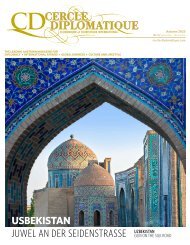CERCLE DIPLOMATIQUE - issue 01/2020
CD is an independent and impartial magazine and is the medium of communication between foreign representatives of international and UN-organisations based in Vienna and the Austrian political classes, business, culture and tourism. CD features up-to-date information about and for the diplomatic corps, international organisations, society, politics, business, tourism, fashion and culture. Furthermore CD introduces the new ambassadors in Austria and informs about designations, awards and top-events. Interviews with leading personalities, country reports from all over the world and the presentation of Austria as a host country complement the wide range oft he magazine.
CD is an independent and impartial magazine and is the medium of communication between foreign representatives of international and UN-organisations based in Vienna and the Austrian political classes, business, culture and tourism. CD features up-to-date information about and for the diplomatic corps, international organisations, society, politics, business, tourism, fashion and culture. Furthermore CD introduces the new ambassadors in Austria and informs about designations, awards and top-events. Interviews with leading personalities, country reports from all over the world and the presentation of Austria as a host country complement the wide range oft he magazine.
You also want an ePaper? Increase the reach of your titles
YUMPU automatically turns print PDFs into web optimized ePapers that Google loves.
L’AUTRICHE ALTERNATIVE INVESTMENTS
Whisky Macallan 1926,
in einer Auktion verkauft
um 1,7 Millionen Euro.
Whisky Macallan 1926,
sold in an auction for 1.7
million euros.
Gemälde: „Vertiefte Regung“ (1928) von Wassily Kandinsky (links) und „Propped“ von Jenny Saville
(verkauft für 9,5 Millionen Pfund bei Sotheby‘s). Paintings: “Vertiefte Regung“ (“Deepened emotion“; 1928)
by Wassily Kandinsky (left) and „Propped“ by Jenny Saville (sold for £ 9.5 million at Sotheby‘s).
von Jeff Koons im Mai 2019 um rund 91
Millionen US-Dollar den Besitzer. Damit
wurde der Stahl-Hase zum teuersten Werk
eines noch lebenden Künstlers. In Summe
geht es aber auch billiger. Laut Artprice.
com wurden im ersten Halbjahr 2019 weltweit
44.203 Kunstwerke versteigert. Knapp
80 Prozent davon erzielten einen Preis zwischen
5.000 und 50.000 US-Dollar. Im
Schnitt war laut den Experten von Artprice
bis Mitte 2019 mit Kunstwerken bei einer
Behaltedauer von 13 Jahren eine jährliche
Rendite von 4,6 Prozent zu erzielen. Auf
Basis einer Auswertung für die Preisentwicklung
von 1.850 Kunstwerken zeigt sich
wiederum, dass ein Investment in Kunst
nicht automatisch von Erfolg gekrönt ist.
Bei 51 Prozent der Werke stieg der Preis,
bei 48 Prozent ging er zurück.
Bei Veranlagungen in alte Autos, die
auch als Garagengold gelten, sind die im
italienischen Maranello erzeugten Sportwagen
von Ferrari das Maß der Dinge. Das
gilt nicht nur wegen des 2018 versteigerten
GTO 250, der einen Preis von 70 Millionen
US-Dollar erzielte. Zwischen Anfang 2007
und Anfang 2016 stiegen die Preise für historische
Ferraris fast um 600 Prozent. Danach
gaben die Preise laut dem Hagerty´s
Ferrari Index aber um rund zehn Prozent
nach. Fast deckungsgleich entwickelten
sich die Preise deutscher Nachkriegsautos
von Porsche bis hin zu Sammlerstücken
von Mercedes Benz. Wer sich vergleichsweise
günstige Autos von Mercedes, BMW
oder Volkswagen, die in den 1980er- oder
1990er-Jahren gebaut wurden, in die Garage
stellte, blickt weiter auf gute Renditen.
Wer schon lange in Gold investiert hat,
blickt auf ansehnliche Gewinne. Hat sich
doch der Preis, in Euro gerechnet, seit 1980
verdreifacht. Aber auch bei Gold als Geldanlage
ist zeitweise Geduld gefragt. So
sackte der Goldkurs von Oktober 2012 bis
Ende 2013 um 38 Prozent ab. Erst ab
Herbstanfang 2018 zog der Preis wieder an.
How much can a car cost? The
answer is up to 70 million US dollars.
That‘s how much an American
businessman turned over at an auction
in 2018 for a Ferrari 250 GTO of which
only 36 were built. Even with noble crescences
you have to be wealthy to get a rare
specimen. For example, last year a bottle of
Macallan Whisky from 1926 changed
hands for 1.7 million euros.
In 2019, many stock markets performed
well. But it is good to have a plan B and to
make investments outside the financial
markets. There are enough alternatives.
These include paintings and sculptures, exquisite
whiskeys and wines as well as precious
stones, gold or even old cars.
Thomas Schröck, head of the gemstone
specialist The Natural Gem: „Gemstones
are a still little-known upscale asset class.
In investments, the red ruby, blue sapphire
and green emerald are the blue chips.
White diamond is not exciting.“ This is
shown by the returns achieved since the financial
crisis. For diamonds, prices have
remained almost constant since 2008.
Emeralds gained on average four percent in
value annually. Blue sapphires gained six
percent annually. For the rarest stone, red
ruby, the increase in value was eight percent
annually.
Where the first whisky was distilled is
unclear. Irish and Scotsmen are still arguing
today about who invented the drink
originally called the „water of life“.
Whoever chooses whisky as a financial investment
should focus on Scottish single
malts. Among the most sought-after crescents
are products from the distilleries
Macallan, Ardbeg, Bowmore, Dalmore,
Springbank, Lagavulin, Glenmorangie or
Laphroaig. In addition, there are whisk(e)
ys from Karuizawa in Japan and the Irish
Scotch Island. Among the most valuable
ones are those distilled before 1975. The
age and quality of the casks are also reflected
in the price.
The return potential of whisk(e)ys is
shown by the Rare Whisky Apex 1000 Index
which reflects the price development of
1,000 single malt Scotch whiskys in demand.
Between the end of 2010 and the
end of January this year, the whisky barometer
rose by 557 per cent, also fueled by
high demand from China, India and Singapore.
According to real estate consultant
Knight Frank, rare whisk(e)y was even the
PHOTOS: BARNEBYS, DALIM, BEIGESTELLT
best alternative asset class in 2018 with a 40
percent increase in value. But the pace cannot
always be kept up. This was evident last
year when the Whisky Apex 1000 Index
rose by only seven percent. It should also
be noted that the index is calculated on the
basis of the performance of bottles, some of
which are very rare, that were auctioned.
In the ranking of the most expensive
whiskys, products from the Macallan Distillery
are in the top five places. Since 2010,
the price per bottle paid at auctions has
ranged from 367,000 to 1.7 million euros.
This is followed by bottles from Dalmore,
Bowmore and Yamazaki, some of which
are more than 60 years old and have fetched
auction proceeds of 114,000 to
145,000 euros. One should not assume that
every bottle of the brown liquid increases
in value. And it is not advisable to buy in
internet shops or at online auctions that are
not specialised in whisk(e)ys, as fake bottles
keep turning up.
In 1945, the Domaine de la Romanée-
Conti winery in Burgundy, France, produced
600 bottles of red wine. Two bottles
came under the hammer at Sotheby‘s New
York in October 2018. One achieved a price
of 558,000 dollars, making it the most
expensive wine in the world. For years, the
purchase of top wines has been worthwhile.
This is shown by the Liv-ex Fine Wine 100
Index, which tracks the performance of 95
of the world‘s best collector‘s wines and five
champagnes. On a five-year view, the index
rose by 27 percent. But setbacks are also
possible. For example, the index fell by 32
percent from mid-2011 to the end of March
2014. Therefore, even an investment in top
wines is no guarantee for lasting capital
growth. In general, value increases are possible
with “Collectibles“, which are
collector‘s items. These are mostly pressed
by top French winemakers in the Bordeaux,
Burgundy and Rhône growing regions.
In mid-May 2019, Claude Monet‘s painting
“Meules“, created in 1890, went under
the hammer at Sotheby‘s New York. The
painting found a buyer for 110.7 million
US dollars. This work shows how, ideally, a
fortune can be made with art. In 1986, the
painting was worth 2.5 million dollars,
only a fraction of the last proceeds.
Also, for sculptures lovers dig deep into
their pockets. For example, Jeff Koons‘
one-meter-high, stainless steel sculpture
“Rabbit“, created in 1986, changed hands
for around 91 million US dollars in May
2019. The steel rabbit thus became the most
expensive work by an artist still alive. But
there are also cheaper options.
According to Artprice.com,
44,203 works of art were auctioned
off worldwide in the
first half of 2019. Almost 80
percent of them fetched a price
between 5,000 and 50,000 US
dollars. According to Artprice
experts, an average annual return
of 4.6 percent could be
achieved by mid-2019 with
works of art with a retention
period of 13 years. On the basis
of an evaluation of the price development
of 1,850 works of art, it is again clear that
an investment in art is not automatically
crowned with success. For 51 percent of the
works, the price rose, for 48 percent it fell.
When it comes to investments in old
cars, which are also considered garage gold,
Ferrari‘s sports cars produced in Maranello,
Italy, are the measure of all things. This
is not only because of the GTO 250, which
was auctioned in 2018 and fetched a price
of 70 million US dollars. Between the beginning
of 2007 and the beginning of 2016,
prices for historic Ferraris rose by almost
600 percent. After that, however, prices fell
by around ten percent according to the
Hagerty‘s Ferrari Index. The prices of German
post-war cars ranging from Porsche to
Mercedes Benz collector‘s items developed
almost identically. Those who put comparatively
inexpensive cars from Mercedes,
BMW or Volkswagen, built in the 1980s or
1990s, into their garages can still look forward
to good returns.
Anyone who has invested
in gold for a long time made
considerable profits. The price
in euro has tripled since
1980. But even with gold as an
investment, patience is required
at times. For example, the
price of gold plummeted by
38 percent from October
2012 to the end of 2013. Only
from the beginning of autumn
2018 did the price rise
again.
Skulptur „Rabbit“ von Jeff
Koons – 91 Millionen
US-Dollar Auktionserlös.
Sculpture “Rabbit“ by Jeff
Koons, sold in an auction for
91 million US dollar.
80 Cercle Diplomatique 1/2020
Cercle Diplomatique 1/2020
81

















